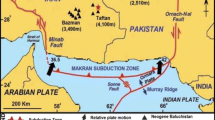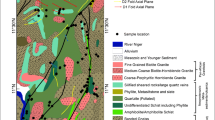Abstract
Geochemical anomaly separation using the concentration–number (C–N) method at the Haftcheshmeh porphyry system in NW Iran is the aim of this study. We used lithogeochemical data sets to explore Cu, Mo, Au and Re mineralization in gabbroic, dioritic and monzonitic units at the Haftcheshmeh Cu–Mo porphyry system. The obtained results were interpreted using a rather extensive set of information available for each mineralized area, consisting of detailed geological mapping, structural interpretation and alteration data. Threshold values of elemental anomalies for the mineralized zone were computed and compared with the statistical methods based on the data obtained from chemical analyses of samples for the lithological units. Several anomalies at local scale were identified for Cu (40 ppm), Mo (12 ppm), Au (79 ppb), and Re (0.02 ppm), and the results suggest the existence of local Cu anomalies whose magnitude generally is above 500 ppm. The log–log plots show the existence of three stages of Cu and Mo enrichment, and two enrichment stages for Au and Re. The third and most important mineralization event is responsible for presence of Cu at grades above 159 ppm. The identified anomalies in Haftcheshmeh porphyry system, and distribution of the rock types, are mainly gabbrodiorite–monzodiorite, granodiorite and monzodiorite–diorite that have special correlation with Cu–Mo and gabbroic and monzonitic rocks, especially the gabbrodiorite–monzodiorite type, which is of considerable importance. The study shows that these elemental anomalous parts have been concentrated dominantly by potassic and phyllic, argillic and propylitic alterations within the gabbroic, monzonitic and dioritic rocks especially in the gabrodioritic type in certain parts of the area. The results, which were compared with fault distribution patterns, revealed a positive correlation between mineralization in anomalous areas and the faults present in the mineralized system.













Similar content being viewed by others
References
Afzal P, Khakzad A, Moarefvand P, Rashidnejad Omran N, Esfandiari B, Fadakar Alghalandis Y (2010) Geochemical anomaly separation by multifractal modeling in Kahang (Gor Gor) porphyry system, Central Iran. J Geochem Explor 104:34–46
Ahrens LH (1954) The lognormal distribution of the elements (a fundamental law of geochemistry and its subsidiary). Geochim Cosmochim Acta 5:49–73
Bai J, Porwal A, Hart C, Ford A, Yu L (2010) Mapping geochemical singularity using multifractal analysis: application to anomaly definition on stream sediments data from Funin Sheet, Yunnan, China. J Geochem Explor 104:1–11
Bolviken B, Stokke PR, Feder J, Jossang T (1992) The fractal nature of geochemical landscapes. J Geochem Explor 43:91–109
Carranza EJM (2009) Controls on mineral deposit occurrence inferred from analysis of their spatial pattern and spatial association with geological features. Ore Geol Rev 35:383–400
Cheng QM (1995) The perimeter–area fractal model and its application to geology. Math Geol 27:69–82
Cheng Q (1999) Spatial and scaling modelling for geochemical anomaly separation. J Geochem Explor 65(3):175–194
Cheng Q, Agterberg FP (1996) Multifractal modeling and spatial statistics. Math Geol 28(1):1–16
Cheng Q, Agterberg FP, Ballantyne SB (1994) The separation of geochemical anomalies from background by fractal methods. J Geochem Explor 51:109–130
Goncalves MA (2001) Characterization of geochemical distributions using multifractal models. Math Geol 33(1):41–61
Goncalves MA, Vairinho M, Oliveira V (1998) Study of geochemical anomalies in Mombeja area using a multifractal methodology and geostatistics. In: Buccianti A, Nardi G, Potenza R (eds) IV IAMG '98. De Frede, Ischia Island, Italy, pp 590–595
Goncalves MA, Mateus A, Oliveira V (2001) Geochemical anomaly separation by multifractal modeling. J Geochem Explor 72:91–114
Hasanpour S (2010) Cu and Au metallogeny and mineralization in Arasbaran zone (Eastern Azerbaijan). Unpublished PhD thesis, Shahid Beheshti University, Earth science faculty, Tehran, Iran
Hawkes RAW, Webb HE (1979) Geochemistry in mineral exploration, 2nd edn. Academic Press, New York, 657 pp
Li C, Ma T, Shi J (2003) Application of a fractal method relating concentrations and distances for separation of geochemical anomalies from background. J Geochem Explor 77:167–175
Lima A, De Vivo B, Cicchella D, Cortini M, Albanese S (2003) Multifractal IDW interpolation and fractal filtering method in environmental studies: an application on regional stream sediments of (Italy), Campania region. Appl Geochem 18:1853–1865
Lowell JD, Guilbert JM (1970) Lateral and vertical alteration–mineralization zoning in porphyry ore deposits. Econ Geol 65:373–408
Mandelbrot BB (1983) The fractal geometry of nature. Freeman, San Fransisco, 468 pp
Mao Z, Peng S, Lai J, Shao Y, Yang B (2004) Fractal study of geochemical prospecting data in south area of Fenghuanshan copper deposit, Tongling Anhui. J Earth Sci Environ 26(4):11–14
Sanderson DJ, Roberts S, Gumiel P (1994) A fractal relationship between vein thickness and gold grade in drill core from La Codosera, Spain. Econ Geol 89:168–173
Shahabpour J (1994) Post-mineral breccia dyke from the Sar-Cheshmeh porphyry copper deposit, Kerman, Iran. Explor Mining Geol 3:39–43
Sim BL, Agterberg FP, Beaudry C (1999) Determining the cutoff between background and relative base metal contamination levels using multifractal methods. Comput Geosci 25:1023–1041
Turcotte DL (1997) Fractals and chaos in geology and geophysics. Cambridge Univ, Press, Cambridge
Turcotte DL (2002) Fractals in petrology. Lithos 65:261–271
Wang QF, Deng J, Wan L, Zhao J, Gong QJ, Yang LQ, Zhou L, Zhang ZJ (2008) Multifractal analysis of the element distribution in skarn-type deposits in Shizishan Orefield in Tongling area, Anhui province, China. Acta Geol Sin 82:896–905
Acknowledgements
The authors acknowledge Mr. M. Kargar and M. Heidari for authorizing the use of the geochemical data set of Haftcheshmeh area in NICOI Company, Tehran, Iran.
Author information
Authors and Affiliations
Corresponding author
Rights and permissions
About this article
Cite this article
Hassanpour, S., Afzal, P. Application of concentration–number (C–N) multifractal modeling for geochemical anomaly separation in Haftcheshmeh porphyry system, NW Iran. Arab J Geosci 6, 957–970 (2013). https://doi.org/10.1007/s12517-011-0396-2
Received:
Accepted:
Published:
Issue Date:
DOI: https://doi.org/10.1007/s12517-011-0396-2




